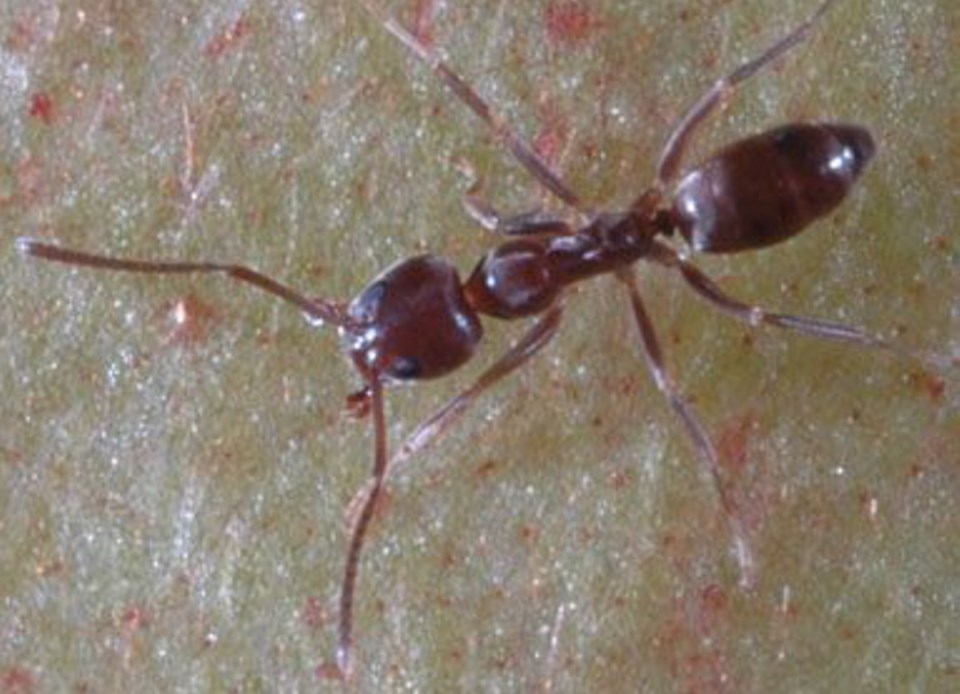One of the 100 worst invasive species on the planet — the Argentine ant — has made its way into Victoria.
The tiny ants, known for building colonies that can stretch up to 1,000 kilometres in length, have been identified in the area along the north side of Oak Bay Avenue between Amphion Street and Richmond Avenue in Victoria.
“While these ants don’t bite and they don’t sting, they’re a nuisance on a scale that we don’t normally see in British Columbia,” said ant expert Rob Higgins.
“They don’t just sort of forage or get into houses the way that most people are familiar with. … These could blanket a countertop in a solid sheet of ants.”
Victoria is the only known Canadian location of the ant, which has been identified on every continent except Antarctica.
Argentine ants are about three millimetres long — smaller than a cellphone audio jack — and light brown in colour.
They are easily confused with the darker-hued “odorous house ant,” said Victoria Pest Control supervisor Kurtis Brown, who first alerted Higgins and other authorities to the infestation.
Argentine ants are most recognizable by their large “supercolonies,” which can see as many as a million insects in 10 square metres of soil.
Brown said he has seen the ants emerge from electrical outlets in buildings, on foundations where the side of a building meets the concrete and on walls and ceilings.
The ants tend to travel in dense “foraging trails,” which can resemble lines up buildings or trees and into homes.
“I’ve seen a trail the width of my arm,” Brown said.
Argentine ant colonies are not competitive with one another, so under the right conditions, they may spread over very large areas. One of the biggest problems, he said, is their competitiveness with other species.
“They’ve actually displaced native ants and are a driver of ecological change,” said Brown, who believes climate change has paved the way for the insect’s movement north.
“It’s already spread farther than anyone ever thought possible,” Brown said.
Higgins, an entomologist at Thompson Rivers University in Kamloops, said if anyone had told him the Argentine art had reached Vancouver Island before he saw the sample, he wouldn’t have believed them.
But he also said that further spread is unlikely. If temperatures were to dip below 2 C for long enough, the species would likely be wiped out.
“There’s a possibility that a really cold snap in Victoria would help knock them back,” Higgins said, noting city and provincial officials plan to map the spread of the insects in coming weeks.
Higgins visited Victoria in February to identify the ants, three months after Brown sent him samples. Brown believes he first saw evidence of them three years ago.
The ants likely travelled from California on plants or plant material, Higgins said.
Each colony has multiple queens and, as with most ant colonies, the best way to control the population is through them.
Higgins said they may be controlled through baits — poisons left out for the workers to bring back to the queens. The active ingredient in the bait should be boric acid or Borax (laundry soap).
“One or just a couple of baits will not suffice,” Higgins says on his website. “You need to aggressively bait. If you have placed what you might consider a ridiculous number of baits in the area, you are on the right track.”
According to a researcher at Clemson University in South Carolina, the ants likely came from Brazil and Argentina via coffee ships sometime before 1891, entering the U.S. through New Orleans.
The Argentine ant isn’t the first invasive species to arrive here, and it won’t be the last, Brown said. The European fire ant was identified in Victoria two summers ago.
“The last couple of years, it seems to be just increasing.”
Most-invasive species
The Argentine ant (linepithema humile) is No. 48 on the Global Invasive Species Database’s list of worst invasive species.
Also in the Top 100:
1. Australian acacia (shrub)
5. The common malaria mosquito
31. Zebra mussels
38. Domestic cat
39. Asian gypsy moth
58. Field mouse
64. Dutch elm disease (fungus)
67. Rabbit
79. North American bullfrog
85. Grey squirrel
98. Common wasp



